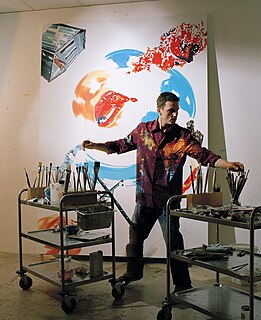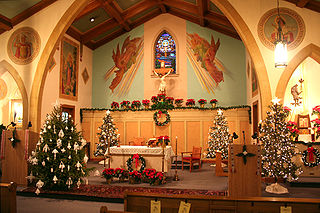Related Research Articles

Matthew Slotover is an English publisher and entrepreneur. He is co-founder of Frieze, a media and events company, which now includes the Frieze Art Fair, frieze and Frieze Academy.

Norbert Bisky is a German artist based in Berlin. He is one of the most important representatives of a new figurative painting in the 21st century.

Samuel Bak is a Lithuanian-American painter and writer who survived the Holocaust and immigrated to Israel in 1948. Since 1993, he has lived in the United States.

Andrius Kubilius is a Lithuanian politician who has been serving as a Member of the European Parliament (MEP) since 2019. He served as Prime Minister of Lithuania from 1999 to 2000 and again from 2008 to 2012. He was leader of the conservative political party Homeland Union.

Lietuvos aidas is a daily newspaper in Lithuania. It was established on September 6, 1917 by Antanas Smetona, and became the semi-official voice of the newly formed Lithuanian government. When the government evacuated from Vilnius to the temporary capital, Kaunas, it ceased publication. The newspaper was revived in 1928 as the newspaper of the Lithuanian government and became the most popular newspaper in Lithuania. At its peak, it published three daily editions with combined circulation of 90,000 copies. World War II disrupted its publication. In 1990, after Lithuania declared independence from the Soviet Union, the newspaper once again became the official newspaper of the Supreme Council of the Republic of Lithuania. At the end of 1992, its circulation reached 103,000 copies. However, it was soon privatized and faced shrinking readership, financial difficulties, and other controversies. In April 2006, bankruptcy proceedings were initiated by the State Tax Inspectorate when its tax debts reached more than 4 million litas. The company was liquidated in 2015, but the newspaper continues to be published by a non-profit organization.
Jonas Zdanys is a bilingual poet, a leading translator of modern Lithuanian fiction and poetry into the English language., and a literary theorist whose writings on translation theory reinforce a conservative humanistic literary agenda. He was born in New Britain, Connecticut, in 1950, a few months after his parents arrived in the United States from a United Nations camp for Lithuanian refugees. He is a graduate of Yale University and earned a Ph.D. in English literature from the State University of New York at Buffalo, where he studied with Robert Creeley among other writers.
Kazys Varnelis was an abstract painter from Lithuania. He lived and worked in the United States of America for fifty years, between 1949 and 1998. His distinctive painting style demonstrated optical and three-dimensional illusions based on geometric abstractions and minimal forms. His style combined elements of constructivism, minimalism, and op art. His work is sometimes described as a modernist interpretation of Lithuanian folk art and is owned by Solomon R. Guggenheim Museum, the Art Institute of Chicago, Currier Museum of Art, and other museums. Varnelis was also an avid collector of antiques and bibliophile – his collection is now housed at the Kazys Varnelis House–Museum in Vilnius. His son, also named Kazys Varnelis is a noted architect, art historian, and theorist.

Saint George Roman Catholic Lithuanian Church was incorporated in Rochester, New York on January 23, 1908 and was the main gathering place for the Lithuanian community of all of western New York state, including of Buffalo, New York, which did not have a Lithuanian church. The centennial celebrations took place on October 10–12, 2008.
Viktorija Daniliauskaitė is a Lithuanian printmaker, and book illustrator.
Aldona Jonuškaitė-Šaltenienė is a Lithuanian ceramic artist.
Vidmantas Jusionis is a Lithuanian painter.
Daniel Gordon is an American artist who lives and works in Brooklyn, New York.

Juozas Kalinauskas is a Lithuanian sculptor and medalist.

Žilvinas Kempinas is a contemporary visual artist. He lives and works in New York City.

Andres Koort is an Estonian painter, scenographer, exhibit designer and curator. He is a member of the Estonian Artists' Association and member of the board of the Estonian Painters' Association since 2002 and has curated and designed some EPA's exhibitions.

Petras Rimša was one of the first professional Lithuanian sculptors and medalists.
Ričardas Bartkevičius is a prominent Lithuanian painter and educator.

Igor Kalinauskas is a Russian artist, theater director, singer and a member of the vocal duo Zikr.

Ghisha Koenig was a British sculptor whose work focused on the work place, especially factories as a hub of human activity.

Vytenis Jankūnas is a Lithuanian-American artist living and working in New York City. His work consists of photographs, paintings and mixed media works.
References
- ↑ Paumgarten, Nick (October 17, 2005). "SALESMAN; Days and nights in Leo Koenig's gallery". The New Yorker . Retrieved March 19, 2011.
- ↑ "Aidas Bareikis: VOLTA Basel".
- ↑ "Archived copy". Archived from the original on 2010-05-26. Retrieved 2010-05-21.
{{cite web}}: CS1 maint: archived copy as title (link) - ↑ http://www.thehappylion.com/index.php?exhibitions=040410_040515 [ dead link ]
- ↑ Johnson, Ken (June 29, 2001). "ART IN REVIEW; Aidas Bareikis -- 'Silence Before the Curve'". The New York Times . Retrieved May 12, 2010.